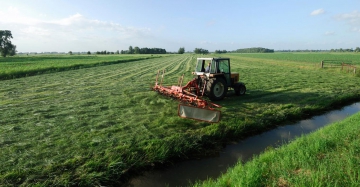Diminishing water resources is a rising global challenge—a challenge that food and beverage companies are uniquely positioned to tackle in order to protect their business, communities and ecosystems around the world.
But in order to take charge and lead successful water stewardship initiatives, companies need to take a holistic approach. As famed American businessman and writer Max De Pree once said: “The first responsibility of a leader is to define reality.”
To me and the rest of the Antea Group team, this means digging deep to evaluate location-specific water needs, risks and opportunities against water access, and then use that information to develop and implement a proactive water stewardship program within your food or beverage organization.
But where do you start?
Below I dive into five critical considerations companies need to think about if they want to rise above the complexities of water stewardship, craft a holistic water stewardship strategy, and achieve a new perspective on what’s possible.
Consideration 1: Water Supply Sustainability
It’s no secret that water is vital to food and beverage businesses; it’s a primary ingredient and production resource. But water is also life to the people, communities and ecosystems surrounding your fields and facilities. As a result, food and beverage companies need to ensure water resources can meet all stakeholders’ needs today, tomorrow and beyond.
Ask yourself: Can the water supply sufficiently meet the current and future needs of the business, surrounding ecosystem, and local community?
Consideration 2: Infrastructure Reliability
Food and beverage companies often operate facilities across diverse geographies and climates, and within regions of varying economic and developmental maturity. Any interruption in energy or water flow can impact resource efficiency, cause downtime or loss of product, and eat into your bottom line. As a result, determining energy and water infrastructure reliability needs to be a key part of your water stewardship approach.
Ask yourself: Are the local energy and water supplies reliable? And what steps need to be taken to mitigate risk?
Consideration 3: Water Quality
From waste dumping to nitrogen pollution from increased fertilizer use, the world’s water supply is becoming increasingly polluted. In fact, 90% of wastewater in developing countries flows untreated into rivers, lakes, streams and critical coastal bodies of water, according to UN-Water.
But water quality issues are not limited to developing countries. In the United States, the growth of agricultural production has resulted in an increase in contaminants making their way into soil and waterways—largely due to polluted runoff caused by rainfall or snowmelt, according to the Centers for Disease Control and Prevention (CDC). Furthermore, UN-Water also reports that the food sector is responsible for about half of the production of organic water pollutants in both high-income and low-income countries.
The bottom line? Local watershed water quality is impacted by several forces—including your own organization—and needs to be a key consideration within your water stewardship initiatives.
Ask yourself: Is water quality or the potential for water contamination a concern within a given watershed? And how do our operations impact water quality and contamination risks?
Consideration 4: Water Governance and Regulations
Compliance is always top-of-mind for food and beverage companies, and it’s often set as a minimum requirement within any sustainability program. But as companies expand operations into new regions or beyond their home country’s borders, they enter unfamiliar regulatory territory.
As a result, understanding local, regional and national water governance rules and regulations is a critical component of holistic water stewardship.
Ask yourself: Are there specific regulatory challenges with regard to water supply, use or consumption, and/or wastewater discharge? Are there trends towards full cost accounting?
Consideration 5: Community Awareness and Concerns
Water is the foundation of life—and water scarcity or quality issues can be hot-button issues within communities around the world. As a result, knowing and understanding community water concerns can help food and beverage companies design a strategy that will protect their brand reputation and do the greatest good for their surrounding communities.
For example, beverage giant PepsiCo became one of the first global companies to recognize water as a basic human right. According to TriplePundit, PepsiCo is helping increase access to clean drinking water around the world, operating water conservation, distribution, purification and hygiene initiatives in underserved communities in China, India, Mali, Brazil and other countries.
Ask yourself: Are water issues regularly covered in the local media and community forums? What are the main concerns within the community? How can our water stewardship strategy address these concerns?
Defining Your Holistic Approach to Water Stewardship
Water is a unique business issue—one that can vary greatly in terms of significance and business implications depending on geography. Taking a holistic approach allows you to tailor your strategy to the unique water challenges your company faces so you can ensure consistency across operations for the long-term.
So now ask yourself: What potential does a holistic approach to water stewardship strategy hold for my company?
I’m betting your answer is: “A lot.”
Learn how beverage companies are tackling water stewardship challenges with the help of Antea Group and our global partners.
Want more news and insights like this?
Sign up for our monthly e-newsletter, The New Leaf. Our goal is to keep you updated, educated and even a bit entertained as it relates to all things EHS and sustainability.
Get e-NewsletterHave any questions?
Contact us to discuss your environment, health, safety and sustainability needs today.





